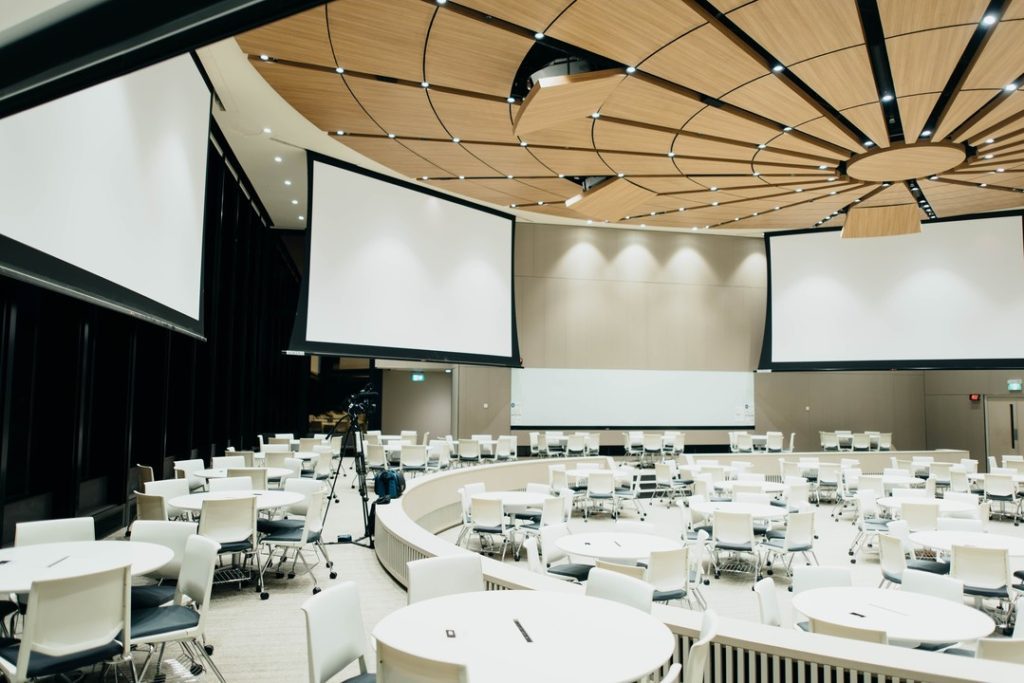As of March 29, only 24.2% of employees in 10 big cities throughout the United States were going into their offices. Some companies have grown accustomed to having people work remotely some or all of the time. Some companies have actually staffed up with remote personnel who may rarely come to the office, if ever. And some staff are anxious about returning at all. That means conference calls and video conferencing will be bigger than ever. Is your space ready?
In case it’s been a while since you actually conducted a virtual conference from your corporate office, you may not remember the sound quality. Even then, if you’ve been conferencing from your home office (or kitchen table) using your laptop, you may have grown accustomed to relatively decent sound quality. In either case, you may not like what you hear when you get back in the office.
The issue is the range of the human voice, which is fairly limited. Unless the speakers and processors for your conference room audio are specifically tuned to render human voices clearly and loudly–without distortion, you may not like what you hear. Surprisingly, the blowers for commercial HVAC systems can also distort or diminish the sound quality…even if you don’t hear the blowers themselves.
Here are a few things you can do to make sure you can hear and understand the attendees on the other end of the line.
Use the Proper Equipment
This would seem obvious. But equipping a conference room for voice exchanges is not the same as rigging one for media playback. And the integrations of suitable systems can get pretty tricky.
Will you be conducting video and audio conferences? Will the audio be supplied along with video from laptops or from dedicated systems? Will you be utilizing tabletop microphones or a single source on a wall?
Too often, companies will fit their conference space with a consumer-grade soundbar. This type of equipment may add excitement to a superhero movie, but you’ll have a hard time understanding what your colleague. Commercial-grade speakers, optimized to deliver clear human speech, are always going to be better. Some examples are Shure products or fully integrated systems like those from Mersive Technologies.
Such systems tend to feature integrated microphones. But such mics are very much dependent on the size and configuration of the room.
Use the Right Room
Choosing the “best” equipment all depends on the room it’s going into. Some equipment will not drive enough sound — or pick up enough participants’ voices — while other systems can be overkill. Overkill doesn’t necessarily mean volume or power. It usually means price. Small meeting and huddle rooms don’t require the same gear as the boardroom. But the boardroom may occasionally be used for informal meetings.
If this is a regular occurrence, there’s every chance that team members will be using their laptops for patching into the conference. In that case, make sure you have adequate connections for people to plug in. In other words, make sure the larger room is the right room for such meetings. (I have mixed feelings about the reference to connections for people to “plugin” as the talk of the town is more advanced tech that allows people to be connected wirelessly or with other tech to by-pass connections…..)
For huddle meetings or one-to-ones with remote personnel, use a huddle room if at all possible. Even then, the room should be properly configured for speakers and listeners to be close to the sound system.
Make Sure The Room Is Ready
If you’ll be reconfiguring your space to accommodate these new meeting styles, you have the chance to easily and cost-effectively create first-rate meeting spaces. This isn’t just about equipment, but materials and furnishings.
The hard surfaces often found in offices are murder on sound quality. The reflected sound can build on itself at an almost imperceptible level that still obscures the detail of voices. Given the inevitable sheetrock, whiteboards, and laminate tabletops in most offices, try to soften the space with carpeting. Drapes on windows — even on indoor glass walls — can mitigate a lot of echo and ambient noise.
Furnish it with upholstered chairs, preferably with woven material that absorbs sound waves. If necessary, consider adding sound-proofing panels. Depending on the decor, such panels can add an artistic touch as well as being functional.
Any of these measures will help create a better space for conferencing by phone or by video. Taken together, you have everything you need for the new style of meetings. Since this is how meetings will be conducted from now on, the better your space, the better your meetings.
And the better your meetings, the better your business.



